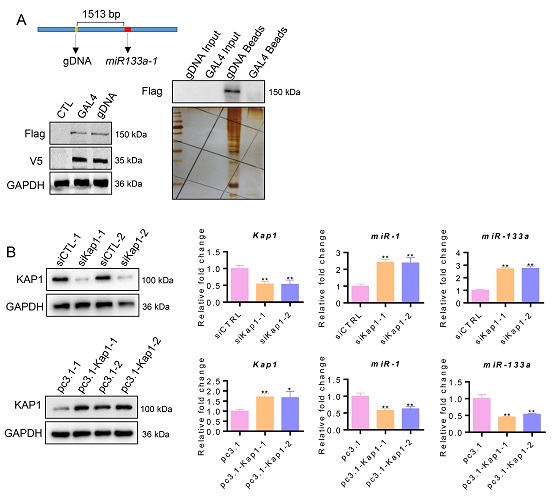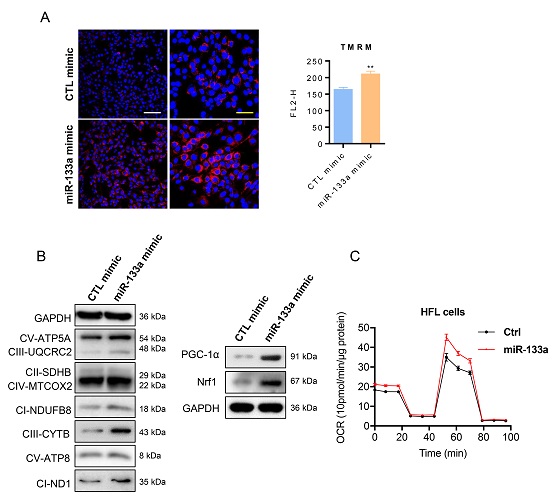WEI Taotao's Group Explains the Function of Transcriptional Regulatory Mechanism of MiR-133a in Cell Differentiation
The international academic journal Cell Death & Disease on September 9, 2020 published a research article titled "KAP1-associated transcriptional inhibitory complex regulates C2C12 myoblasts differentiation and mitochondrial biogenesis via miR-133a repression". It was co-authored by the group of WEI Taotao, a researcher from the Institute of Biophysics (IBP) under the Chinese Academy of Science, and the group of TU Yaping, a professor from the School of Medicine at Creighton University. It was another major achievement jointly made by them.
Researchers found that the upregulated expression of miR-133a can induce the biogenesis of mitochondria and the differentiation of myoblasts. They also utilized the technology of CAPTURE to ascertain the regulatory role of KAP1 in the upstream region in the expression of miR-133a, further deepening their understanding of the transcriptional and regulatory mechanism of miR-133a, together with its function.
MicroRNA (miRNA) plays an important role in physiological and pathophysiological process. During their preparation work, the teams of WEI and TU conducted molecular, cellular and animal-related experiments to ascertain that the TGF-β1-induced expression of miR-133a can exert an influence on TGF-β1 receptors and their effector molecules via negative feedback regulation, regulate the signaling pathways of TGF-β1, inhibit and even partially reverse the progression of idiopathic pulmonary fibrosis (IPF). Relevant research article titled "Transforming growth factor (TGF)-β1-induced miR-133a inhibits myofibroblast differentiation and pulmonary fibrosis" was published on Cell Death & Disease journal on September 11, 2019.
Given the important function of miR-133a in physiology and pathophysiology, the exploration of its regulatory mechanism will provide important clues to the treatment of pulmonary fibrosis and other related diseases. Moreover, the teams of WEI and TU took the dynamic expression of miR-133a in the differentiation of myoblasts as a model, utilized CRISPR/Cas9-based CAPTURE technique, and combined the methods of high-throughput sequencing and bioinformatics to analyze the regulatory mechanism of miR-133a expression.
The researchers found that KAP1-associated transcriptional complex accounts for the suppression of miR-133a in C2C12 myoblasts. The knockdown of KAP1 will increase the expression of miR-133a, which occurs in parallel to the biogenesis of mitochondria and the differentiation of C2C12 myoblasts. The upregulation of miR-133a can induce the biogenesis of mitochondria and the differentiation of C2C12 myoblasts, whereas miR-133a inhibitor can significantly deter cell differentiation.
It is the first study that has utilized the CAPTURE technique to identify the regulatory factors of miR-133a during cell differentiation, which provides new ideas for probing into the precision regulatory machinery of miRNAs during different biological processes.
WEI Peng, a doctoral student with the team of WEI Taotao and also supervised by Prof. TU, is the first author of the research article published in 2019, while ZHANG Jialing is the first author of the research article published in 2020. Researcher WEI Taotao and Prof. Tu are the corresponding authors of the two research articles, which have received financial assistance from National Key Research and Development Program of China with the Ministry of Science and Technology, National Natural Science Foundation of China, and National Laboratory of Biomacromolecules.

Figure 1. With a focus on CAPTURE enrichment technique and regulatory protein at the upstream region of miR-133a genes, mass spectrum identification shows that KAP1-associated transcriptional inhibitory factors can be combined with the upstream region of miR-133a genes (A). The upregulated expression of KAP1 will lower the expression of miR-1/133a, whereas the knockdown of KAP1 will lead to the expression of miR-1/133a (B).
(Image by Dr. WEI Taotao's group)

Figure 2. MiR-133a will remarkably increase mitochondrial transmembrane potential (A), upregulate the expression of mitochondrial electron transport complex subunits via PGC-1 /Nrf1 (B), and strengthen mitochondrial oxidative phosphorylation (C).
(Image by Dr. WEI Taotao's group)
The web links for two research articles:
https://www.nature.com/articles/s41419-020-02937-5
https://www.nature.com/articles/s41419-019-1873-x
Contact: WEI Taotao
Institute of Biophysics, Chinese Academy of Sciences
Beijing 100101, China
Email: weitt@ibp.ac.cn
(Reported by Dr. WEI Taotao's group)

